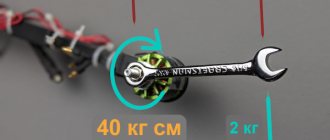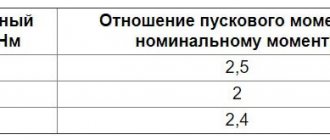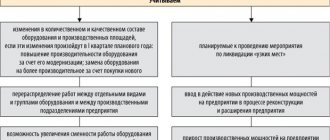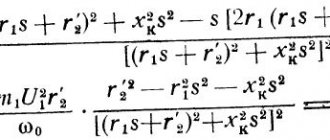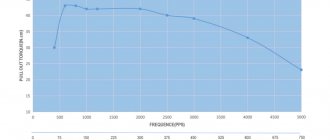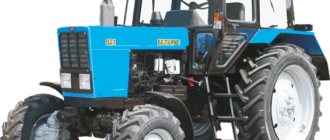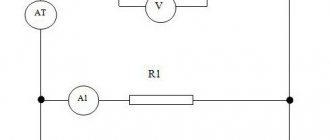Let's look at 5 popular ways to calculate the power of a car engine using data such as:
- engine speed,
- engine volume,
- torque,
- effective pressure in the combustion chamber,
- fuel consumption,
- injector performance,
- machine weight
- acceleration time to 100 km.
Each of the formulas used to calculate the power of a car engine is quite relative and cannot determine with 100% accuracy the real horsepower of the driving car. But by making calculations for each of the above garage options, based on certain indicators, you can calculate at least the average value, whether it’s a stock or tuned engine, literally with a 10 percent error .
Power is the energy generated by the engine, it is converted into torque on the output shaft of the internal combustion engine. This is not a constant value. Next to the maximum power values, the speed at which it can be achieved is always indicated. The maximum point is reached at the highest average effective pressure in the cylinder (depending on the quality of filling with fresh fuel mixture, combustion completeness and heat losses). Modern engines produce the greatest power on average at 5500–6500 rpm. In the automotive industry, engine power is measured in horsepower. Therefore, since most results are displayed in kilowatts, you will need a kW to hp conversion calculator.
How to calculate power through torque
The simplest calculation of car engine power can be determined by the relationship between torque and revolutions .
Torque
The force multiplied by the leverage of its application, which the engine can produce to overcome certain resistance to movement. Determines how quickly the motor reaches maximum power. Calculation formula for torque based on engine volume:
Micro = VHxPE/0.12566
, Where
- VH – engine displacement (l),
- PE – average effective pressure in the combustion chamber (bar).
Engine speed
Crankshaft rotation speed.
The formula for calculating the power of an internal combustion engine of a car is as follows:
P = Mkr * n/9549 [kW]
, Where:
- Mcr – engine torque (Nm),
- n – crankshaft speed (rpm),
- 9549 is a coefficient so that the revolutions can be substituted in rpm, and not in alpha cosines.
Since according to the formula, we get the result in kW, then, if necessary, you can also convert to horsepower or simply multiply by a factor of 1.36.
Using these formulas is the easiest way to convert torque to power.
And in order not to go into all these details, a quick calculation of the power of an internal combustion engine online can be done using our calculator.
But, unfortunately, this formula reflects only the effective power of the motor, which does not all reach the wheels of the car. After all, there are losses in the transmission, transfer case, parasitic consumers (air conditioning, generator, power steering, etc.) and this does not take into account such forces as rolling resistance, lifting resistance, aerodynamic resistance.
Main types of electric motors
There are many types and modifications of electric motors. Each of them has its own power and other parameters.
The main classification divides these devices into DC and AC motors. The first option is used much less frequently, since its operation requires the presence of a direct current source or a device that converts alternating voltage into direct current. Fulfilling this condition in modern production will require significant additional costs.
But, despite significant disadvantages, DC motors have a high starting torque and operate stably even at high overloads. Due to their qualities, these units are widely used in electric transport, in the metallurgical and machine tool industries.
However, most modern equipment runs on AC motors. The operation of these devices is based on electromagnetic induction, which is created in a magnetic field by a conducting medium. The magnetic field is created using windings flowing around currents or using permanent magnets. Electric motors operating on alternating current can be synchronous or asynchronous.
The use of synchronous electric motors is practiced in equipment where a constant rotation speed is required. These are DC generators, pumps, compressors and other similar installations. Different models differ in their own technical characteristics. For example, the rotation speed can be in the range of 125-1000 rpm, and the power reaches 10 thousand kilowatts.
Many designs have a short-circuited winding located on the rotor. With its help, if necessary, an asynchronous start is made, after which the synchronous motor continues to operate as usual, minimizing electrical energy losses. These engines are characterized by their small size and high efficiency.
Asynchronous AC motors have become much more widespread in the manufacturing sector. They are characterized by a very high frequency of rotation of the magnetic field, significantly exceeding the speed of rotation of the rotor. A significant disadvantage of these devices is considered to be a decrease in efficiency to 30-50% of the norm at low loads. In addition, during start-up, the current parameters become several times greater compared to operating indicators. These problems are eliminated by using frequency converters and soft starters.
Asynchronous motors are used in those facilities where frequent switching on and off of equipment is required, for example, in elevators, winches, and other devices.
How to calculate power by engine volume
If you do not know the torque of your car’s engine, then to determine its power in kilowatts you can also use a formula of this type:
Ne = Vh * pe * n/120
(kW), where:
- Vh — engine volume, cm³
- n — rotation speed, rpm
- pe is the average effective pressure, MPa (for conventional gasoline engines it is about 0.82 - 0.85 MPa, for forced ones - 0.9 MPa, and for diesel engines from 0.9 and to 2.5 MPa, respectively).
To obtain engine power in “horses” rather than kilowatts, the result should be divided by 0.735.
Table for translation l. With. in kW
To calculate the motor power in kW, you need to use the proportion 1 kW = 1.3596 hp. With . Its reverse form: 1 l. With. = 0.73549875 kW. This is how these two units are mutually converted into each other.
| kW | hp | kW | hp | kW | hp | kW | hp | kW | hp | kW | hp | kW | hp |
| 1 | 1.36 | 30 | 40.79 | 58 | 78.86 | 87 | 118.29 | 115 | 156.36 | 143 | 194.43 | 171 | 232.50 |
| 2 | 2.72 | 31 | 42.15 | 59 | 80.22 | 88 | 119.65 | 116 | 157.72 | 144 | 195.79 | 172 | 233.86 |
| 3 | 4.08 | 32 | 43.51 | 60 | 81.58 | 89 | 121.01 | 117 | 160.44 | 145 | 197.15 | 173 | 235.21 |
| 4 | 5.44 | 33 | 44.87 | 61 | 82.94 | 90 | 122.37 | 118 | 160.44 | 146 | 198.50 | 174 | 236.57 |
| 5 | 6.80 | 34 | 46.23 | 62 | 84.30 | 91 | 123.73 | 119 | 161.79 | 147 | 199.86 | 175 | 237.93 |
| 6 | 8.16 | 35 | 47.59 | 63 | 85.66 | 92 | 125.09 | 120 | 163.15 | 148 | 201.22 | 176 | 239.29 |
| 7 | 9.52 | 36 | 48.95 | 64 | 87.02 | 93 | 126.44 | 121 | 164.51 | 149 | 202.58 | 177 | 240.65 |
| 8 | 10.88 | 37 | 50.31 | 65 | 88.38 | 94 | 127.80 | 122 | 165.87 | 150 | 203.94 | 178 | 242.01 |
| 9 | 12.24 | 38 | 51.67 | 66 | 89.79 | 95 | 129.16 | 123 | 167.23 | 151 | 205.30 | 179 | 243.37 |
| 10 | 13.60 | 39 | 53.03 | 67 | 91.09 | 96 | 130.52 | 124 | 168.59 | 152 | 206.66 | 180 | 144.73 |
| 11 | 14.96 | 40 | 54.38 | 68 | 92.45 | 97 | 131.88 | 125 | 169.95 | 153 | 208.02 | 181 | 246.09 |
| 12 | 16.32 | 41 | 55.74 | 69 | 93.81 | 98 | 133.24 | 126 | 171.31 | 154 | 209.38 | 182 | 247.45 |
| 13 | 17.67 | 42 | 57.10 | 70 | 95.17 | 99 | 134.60 | 127 | 172.67 | 155 | 210.74 | 183 | 248.81 |
| 14 | 19.03 | 43 | 58.46 | 71 | 96.53 | 100 | 135.96 | 128 | 174.03 | 156 | 212.10 | 184 | 250.17 |
| 15 | 20.39 | 44 | 59.82 | 72 | 97.89 | 101 | 137.32 | 129 | 175.39 | 157 | 213.46 | 185 | 251.53 |
| 16 | 21.75 | 45 | 61.18 | 73 | 99.25 | 102 | 138.68 | 130 | 176.75 | 158 | 214.82 | 186 | 252.89 |
| 17 | 23.9 | 46 | 62.54 | 74 | 100.61 | 103 | 140.04 | 131 | 178.9 | 159 | 216.18 | 187 | 254.25 |
| 18 | 24.47 | 47 | 63.90 | 75 | 101.97 | 104 | 141.40 | 132 | 179.42 | 160 | 217.54 | 188 | 255.61 |
| 19 | 25.83 | 48 | 65.26 | 76 | 103.33 | 105 | 142.76 | 133 | 180.83 | 161 | 218.90 | 189 | 256.97 |
| 20 | 27.19 | 49 | 66.62 | 78 | 106.05 | 106 | 144.12 | 134 | 182.19 | 162 | 220.26 | 190 | 258.33 |
| 21 | 28.55 | 50 | 67.98 | 79 | 107.41 | 107 | 145.48 | 135 | 183.55 | 163 | 221.62 | 191 | 259.69 |
| 22 | 29.91 | 51 | 69.34 | 80 | 108.77 | 108 | 146.84 | 136 | 184.91 | 164 | 222.98 | 192 | 261.05 |
| 23 | 31.27 | 52 | 70.70 | 81 | 110.13 | 109 | 148.20 | 137 | 186.27 | 165 | 224.34 | 193 | 262.41 |
| 24 | 32.63 | 53 | 72.06 | 82 | 111.49 | 110 | 149.56 | 138 | 187.63 | 166 | 225.70 | 194 | 263.77 |
| 25 | 33.99 | 54 | 73.42 | 83 | 112.85 | 111 | 150.92 | 139 | 188.99 | 167 | 227.06 | 195 | 265.13 |
| 26 | 35.35 | 55 | 74.78 | 84 | 114.21 | 112 | 152.28 | 140 | 190.35 | 168 | 228.42 | 196 | 266.49 |
| 27 | 36.71 | 56 | 76.14 | 85 | 115.57 | 113 | 153.64 | 141 | 191.71 | 169 | 229.78 | 197 | 267.85 |
| 28 | 38.07 | 57 | 77.50 | 86 | 116.93 | 114 | 155.00 | 142 | 193.07 | 170 | 231.14 | 198 | 269.56 |
Calculation of engine power based on air flow
The same approximate calculation of engine power can be determined by air flow. The function of such a calculation is available to those who have an on-board computer installed, since it is necessary to record the flow rate when the car engine, in third gear, is spun up to 5.5 thousand revolutions. We divide the resulting value from the mass air flow sensor by 3 and get the result.
The formula for calculating the power of an internal combustion engine based on air flow ultimately looks like this:
Gw [kg]/3=P[hp]
This calculation, like the previous one, shows gross power (bench test of the engine without taking into account losses), which is 10-20% higher than the actual one. It is also worth considering that the readings of the mass air flow sensor are highly dependent on its contamination and calibrations.
Calculation of power by weight and acceleration time to hundreds
Another interesting way to calculate engine power using any type of fuel, be it gasoline, diesel or gas, is by acceleration dynamics. To do this, using the weight of the car (including the pilot) and acceleration time to 100 km. And in order for the Power Calculation Formula to be as close to the truth as possible, it is also necessary to take into account slipping losses depending on the type of drive and the speed of reaction of different gearboxes. The approximate loss at start for front-wheel drive will be 0.5 seconds. and 0.3-0.4 for rear-wheel drive cars.
Using this internal combustion engine power calculator, which will help determine the engine power based on the dynamics of acceleration and weight, you can quickly and accurately find out the power of your iron horse without delving into the technical characteristics.
External speed characteristic (VSCH)
The external speed characteristic of the engine shows the dependence of power, fuel consumption and torque on the crankshaft speed. All these parameters are shown graphically in the form of curves.
External speed characteristic
In the figure you can see curves with the designations Pe - engine power, Me - torque, ge - specific fuel consumption. As you can see, with increasing speed and power, fuel consumption increases. The torque increases to a certain level and then decreases. At the point where the engine torque and power are most efficient, there will be the most optimal fuel consumption.
Motor manufacturers are fighting to ensure that the engine develops maximum torque in the widest possible speed range (“the torque plateau is wider”), and maximum power is achieved at speeds as close as possible to this shelf. Such an engine will pull you out of the swamp and allow you to accelerate quickly in the city.
The external speed characteristic evaluates the dynamic characteristics of the car, determines efficiency and fuel consumption for different parameters.
High torque at lower speeds increases the unit's traction force, load capacity and maneuverability.
Calculation of internal combustion engine power based on injector performance
An equally effective indicator of the power of a car engine is the performance of the injectors. Previously, we looked at its calculation and relationship, therefore, it will not be difficult to calculate the amount of horsepower using the formula. The estimated power is calculated according to the following scheme:
Where, the load factor is no more than 75-80% (0.75...0.8), the mixture composition at maximum performance is somewhere around 12.5 (rich), and the BSFC coefficient will depend on what kind of engine you have, naturally aspirated or turbocharged (atmo - 0.4-0.52, for turbo - 0.6-0.75).
Having found out all the necessary data, enter the indicators into the appropriate cells of the calculator and by clicking the “Calculate” button you will immediately receive a result that will show the real engine power of your car with a slight error. Please note that you do not necessarily need to know all the parameters presented; you can clear the power of the internal combustion engine using a separate method.
The value of the functionality of this calculator lies not in calculating the power of a stock car, but if your car has been tuned and its weight and power have undergone some changes.
The history of horsepower
Calculation of fuel consumption based on engine power formula
At the end of the 18th century, English miners used the Newcomen steam plant to pump water out of mines. Physicist Watt decided to improve this machine and increase its performance. Working on it, he made it 4 times more effective. In addition to the fact that he made the piston stroke in both directions, a mechanism was developed for transmitting movement from the piston to the rocker arm.
This is how a steam engine was created, converting the movement of a translational piston into rotation. This produced a whole revolution and opened up opportunities to apply it in various fields. The company of Watt and his partner Bolton produced 496 devices by 1800. Only less than a quarter of them were used as pumps. The need to sell your products has necessitated the determination of their technical characteristics.
The main indicator that buyers had to pay attention to was the power of the heat engine.
When James Watt wanted to show how many horses a steam engine could replace at work, he coined the term “horsepower” - l. With. The Scottish inventor decided to come up with this standard after one incident. It was said that in 1789, a brewer, having bought an engine, compared the efficiency of its work in turning a water pump with the similar work of a strong horse. Trying to convict James of the failure of his invention, the brewer forced one of his strong and hardy horses to work hard. The engineer accepted the challenge and slightly exceeded the brewer's stated "technical specification" for one horse.
FAQ
How to calculate the power of an internal combustion engine?
Engine power in kW can be calculated from engine size and crankshaft speed. The formula for calculating engine power is: Ne = Vh * Pe * n / 120 (kW), where: Vh - engine volume, cm³ n - number of crankshaft revolutions per minute Pe - average effective pressure, MPa
What coefficient should be taken into account when calculating engine power?
The power factor (cosϕ) for calculating the power of an electric motor is taken equal to 0.8 for low-power motors (less than 5.5 kW) or 0.9 for motors with a power of over 15 kW.
How to calculate engine power from torque?
To determine the engine power in kilowatts, when the torque is known, you can use the following formula: P = Mcr * n/9549, where: Mcr – torque (Nm), n – crankshaft speed (rpm), 9549 – coefficient for converting revolutions to rpm.
